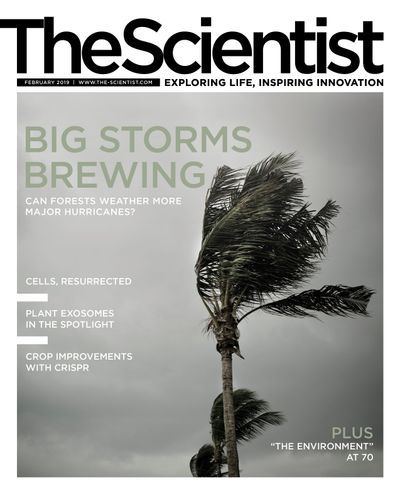Login
SubscribeFeatures

How Trees Fare in Big Hurricanes
Amber Dance | Feb 1, 2019 | 10+ min read
Forests are resilient, but researchers wonder if climate change will outpace their adaptations.

Cell Death Processes Are Reversible
Charles Q. Choi | Feb 1, 2019 | 10+ min read
Molecular programs can rescue cells already engaged in the process of apoptosis or other forms of programmed cell death.

Exosomes Make Their Debut in Plant Research
Amanda Keener | Feb 1, 2019 | 10+ min read
A growing branch of research on how plants use exosomes to interact with their environment is opening up a new field of plant biology.
Contributors
Contributors
Contributors
Meet some of the people featured in the February 2019 issue of The Scientist.
Editorial
The World Within
The World Within
Internalizing the environment might be the next step in humans’ relationship with our planet.
Speaking of Science
Ten-Minute Sabbatical
Ten-Minute Sabbatical
Take a break from the bench to puzzle and peruse.
Freeze Frame
Caught on Camera
Caught on Camera
Selected Images of the Day from the-scientist.com
Notebook
Boosting Plants’ Uptake of Vitamins and Minerals
Boosting Plants’ Uptake of Vitamins and Minerals
With genetic tweaks, researchers can coax corn and other cereals to take in more iron, but sometimes the plants rebel.
A Keen Sense of Smell Appears to Go Hand in Hand with Spatial Memory
A Keen Sense of Smell Appears to Go Hand in Hand with Spatial Memory
Authors of a small study say the two abilities likely evolved in tandem.
An Algorithm to Predict the Age of Your Lab Mice
An Algorithm to Predict the Age of Your Lab Mice
Researchers develop an app that can estimate the biological age of a rodent from its mug shot—and could give a boost to the science of human aging in the process.
Clues to How Ancient Plants Handled Fungal Pests
Clues to How Ancient Plants Handled Fungal Pests
In plants ranging from liverworts to wheat, parasitic water molds build intracellular structures analogous to the nutrient-exchanging structures of symbiotic fungi.
Critic at Large
Opinion: GE Crops Are Seen Through a Warped Lens
Opinion: GE Crops Are Seen Through a Warped Lens
Risks that pertain to all manner of new crops are often misattributed to genetic engineering. This distorts the public’s view of the technology.
Modus Operandi
Better Base Editing in Plants
Better Base Editing in Plants
Adenine editing enzymes have been adapted for use in plants.
The Literature
Molecules Found in Ginger Remodel the Microbiome
Molecules Found in Ginger Remodel the Microbiome
Small RNA-containing particles in ginger root are found to promote the growth of beneficial bacteria and alleviate colitis in mouse guts.
Bacteria Use Plants’ Trick to Take Their Iron
Bacteria Use Plants’ Trick to Take Their Iron
Pathogens appear to steal the metal from plants using the erratic motion of microscopic particles.
Presence of Bacterial Pathogen Blocks Arabidopsis Germination
Presence of Bacterial Pathogen Blocks Arabidopsis Germination
A compound produced by Pseudomonas aeruginosa activates signaling pathways that prevent seeds from growing in unfavorable environments.
Profile
Perennial Explorer: A Profile of Neelima Sinha
Perennial Explorer: A Profile of Neelima Sinha
This University of California, Davis, botanist studies the genes that regulate plant anatomy.
Scientist to Watch
Zach Lippman Susses Out How Gene Regulation Affects Plant Phenotypes
Zach Lippman Susses Out How Gene Regulation Affects Plant Phenotypes
The Cold Spring Harbor Laboratory researcher is fueled by curiosity about how one species’ genome can produce a wide variety of traits.
Lab Tools
Mapping the Cellular Social Network of Proteins
Mapping the Cellular Social Network of Proteins
Three techniques capture data on numerous protein interactions in plants, mice, and human cells.
Bio Business
Companies Use CRISPR to Improve Crops
Companies Use CRISPR to Improve Crops
The agritech industry is editing plant genomes to feed a growing population, expand the produce aisle, and make tastier, more convenient food products.
Reading Frames
“The Environment” Is Only 70 Years Old
“The Environment” Is Only 70 Years Old
A new book traces the surprisingly short history of the environment as a shared conceptual construct.
Foundations
Flower Preservation, 1916
Flower Preservation, 1916
James Kirkham Ramsbottom saved Britain’s daffodil industry from a devastating parasite, only to be forgotten.
Infographics
Infographic: How Forests Survive the Storm
Infographic: How Forests Survive the Storm
Trees are resilient, but researchers wonder if climate change will outpace their adaptations.
Infographic: How Cells Cheat Death
Infographic: How Cells Cheat Death
Apoptosis and other types of programmed cell death appear to be reversible.
Infographic: Plants Deploy Exosomes to Stop Alien Invaders
Infographic: Plants Deploy Exosomes to Stop Alien Invaders
A growing branch of research on how plants use exosomes to interact with their environment is opening up a new field of plant biology.
Infographic: Plant Genome Editors Get A New Tool
Infographic: Plant Genome Editors Get A New Tool
Adenine editing enzymes have been adapted for use in plants.
Infographic: How Ginger Remodels the Microbiome
Infographic: How Ginger Remodels the Microbiome
Small microRNA-containing particles found in the plant can boost populations of healthy gut bacteria, and even improve colitis symptoms in mice.
























